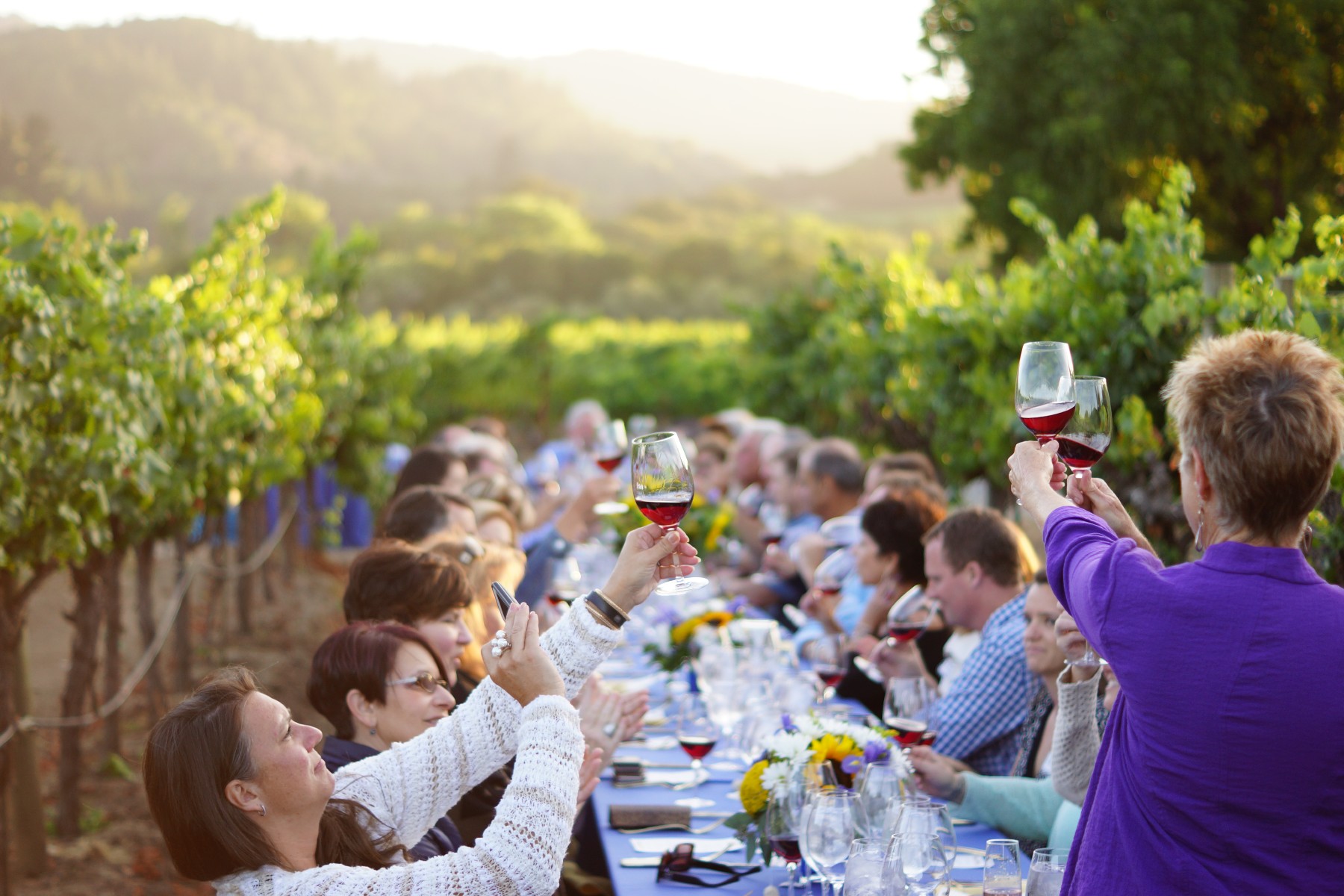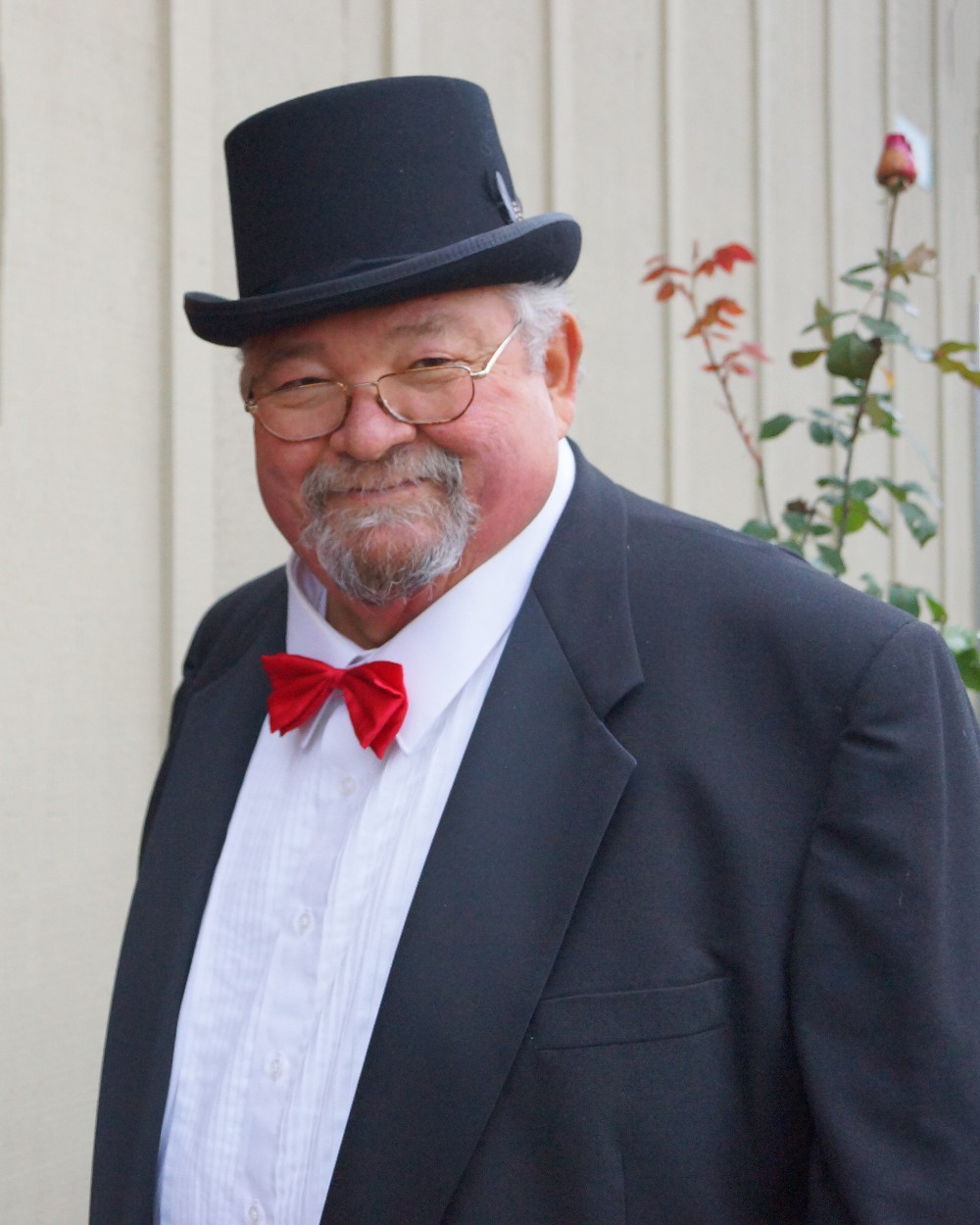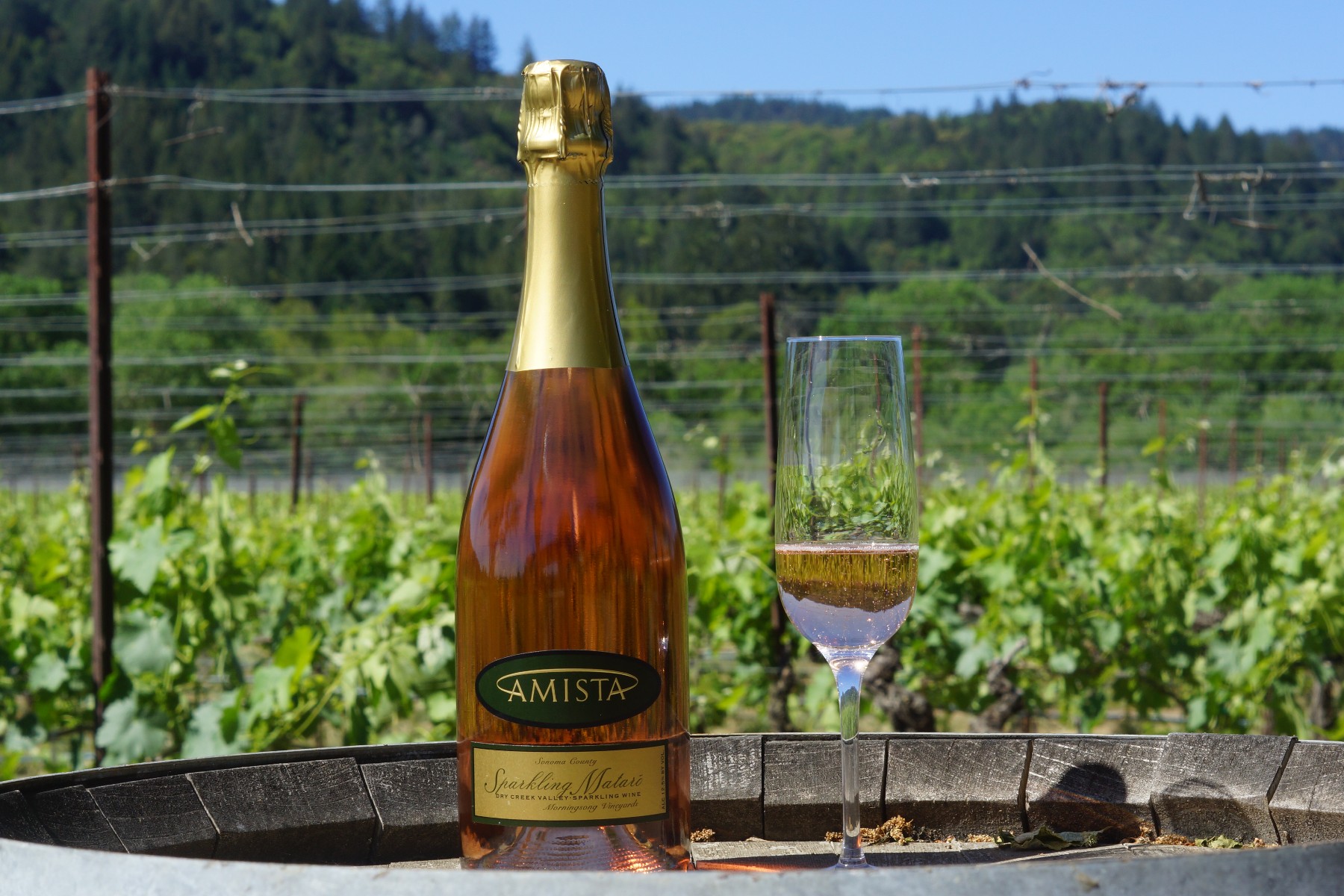News from Amista Vineyards
Celebrate July 4th with Perfect Grilling and Wine Pairings from Amista
Three of Mike's Favorites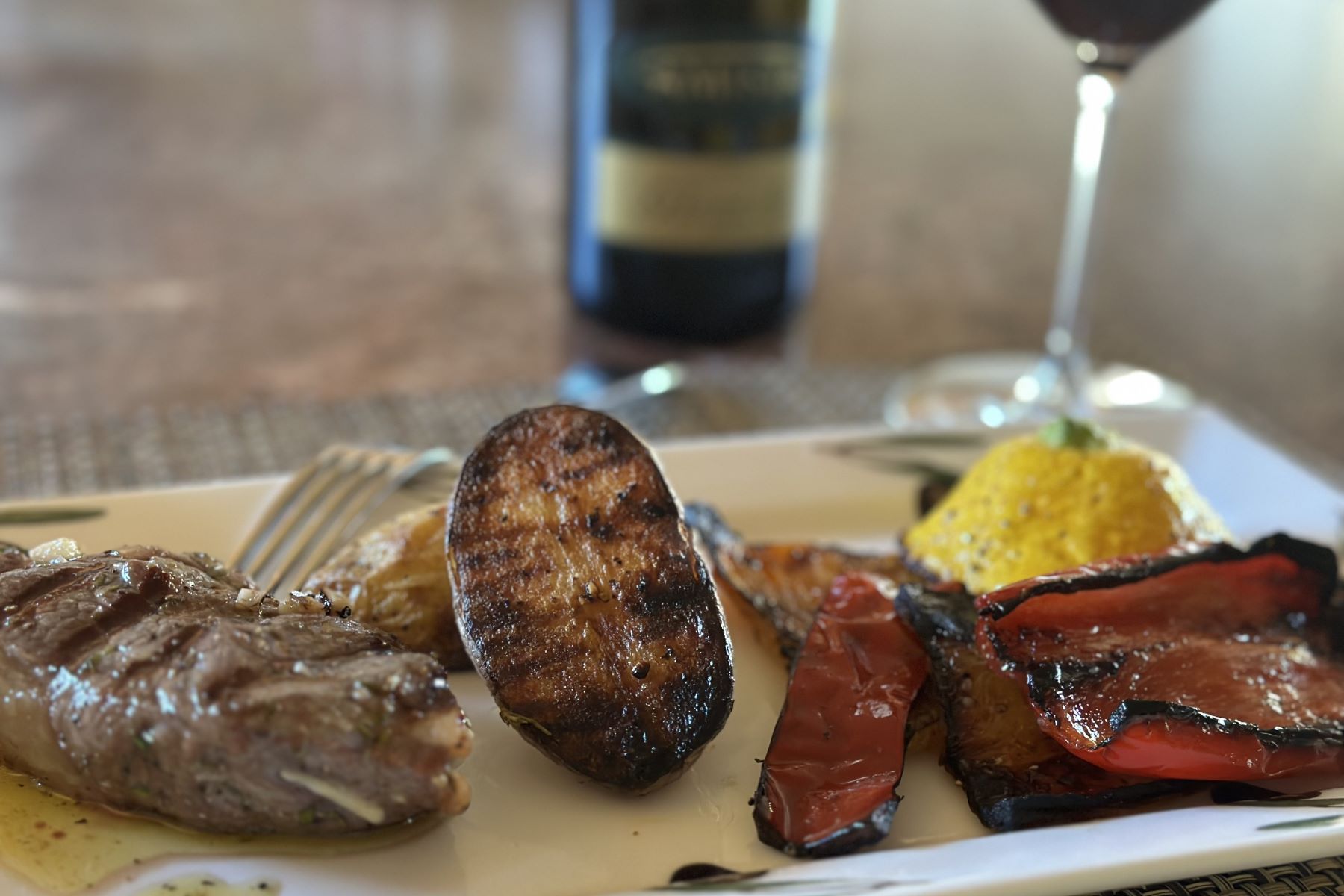
...that inspired my grilling journey.
July 4th is the quintessential day for grilling, making it the perfect time to share three simple and delicious grilling options, each paired with an Amista wine.
I Had to Learn to Grill!
One of the things I realized was that I had never grilled anything in my entire life. Growing up, my dad was the grill master. In college, I couldn’t afford a grill and it didn't fit in my dorm room. When I married Mike over 40 years ago, he assumed all grilling duties. I love grilled food, so I was determined to learn. Surprisingly, it turned out to be easier than I thought!
In addition to grilling, Mike was our home chef. He loved to cook and bake bread. My contributions were making salads and cleaning up. Now that I have to do everything, I prefer simple yet delicious meals that showcase the incredible farm-to-table bounty we have in Sonoma wine country. When grilling, I like to prepare the entire meal on the grill to avoid heating the oven or messing up the stove. Here are three of Mike’s favorites that I’m learning to master.
Grilled Salmon and Amista Grenache
Mike always chose a tail fillet of a nice piece of salmon, seasoned it with salt, pepper, and lots of dried dill, and marinated it for about 30 minutes in Mr. Yoshida’s sauce (you can substitute teriyaki sauce and a little honey). He would then place it skin-side down on the grill, turning it briefly. The challenge is getting it off the grill while it’s still moist and succulent.
I like to serve it with vegetables done in a grill basket. My favorites are fennel (which is amazing with salmon), broccoli, and red pepper. I chop all the vegetables, toss them with olive oil, salt, and pepper, and then throw them in the grill basket. They just need a quick stir about halfway through. On my grill, they take about six minutes total.
Amista Grenache pairs wonderfully with grilled salmon. It’s a lighter red that doesn’t overpower the salmon. On a hot summer day, it’s great to chill it in the refrigerator for 20 minutes before serving—a trick I learned from our Amista winemaker, Ashley Herzberg.
Grilled Rib-eye and Amista Syrah
Mike and I didn’t eat much steak, but every so often, a juicy rib-eye was a special treat. The wonderful thing about grilling is that most meats require very little preparation. In this case, just salt and pepper on both sides is all it takes.
My favorite part of this meal is the grilled Yukon gold potatoes. I don’t know if Mike made up this preparation or saw it on one of the many cooking shows he liked to watch, but it’s now my favorite way to make potatoes. He cleaned the potatoes, left the skins on, and cut each in half lengthwise. He put them in a microwave-safe bowl, covered it with plastic wrap, and used the Steam Cook setting for potatoes on our microwave.
Just a note: the plastic wrap expands into a huge bubble from the steam, so be extremely careful when you remove it to avoid burns. Mike liked to poke it with a sharp knife to let the steam escape before removing the wrap.
Then he drained the potatoes, added salt, pepper, and olive oil, and placed them cut side down on the grill. They are already fully cooked, so all they need are those great grill marks and a little crispiness. Add a selection of grilled vegetables, and you have a hearty summer supper.
Syrah is the suggested pairing because we specialize in Rhône wines and it was the first wine Mike made in our garage when we moved to Healdsburg. However other Amista reds like the Rockpile Cabernet or the Interlude Zinfandel would also be wonderful. The tannins in all of these wines help to cut the richness of the steak.
One of our favorite things to do was open two different wines to see which one paired best. It meant we had two bottles open, but if stored properly, they were ready to drink another night. I haven’t tried it yet, but I want to pair our Mourvèdre with a steak. I bet it will be fantastic.
Grilled Hamburgers and Amista Tres
The Fourth of July screams for hamburgers. Mike used 80/20 ground beef, shaped into thick patties, and sprinkled with salt and pepper. We liked them medium rare, served on Mike’s homemade hamburger buns that he placed face-down on the grill for a few moments to toast. With freshly made buns and all the condiments, we didn’t need anything else—except a glass of wine—to enjoy a satisfying summer meal.
Guess which wine Mike liked with his favorite meal? It had to be Amista Tres, his favorite wine. Tres has notes of dark fruits and just the right spiciness to complement the hamburger and condiments.
Enjoy these delicious recipes and wine pairings as you celebrate July 4th. Happy grilling!
Everything You Need to Know About Rosé
What it is, how it's made, perfect pairings...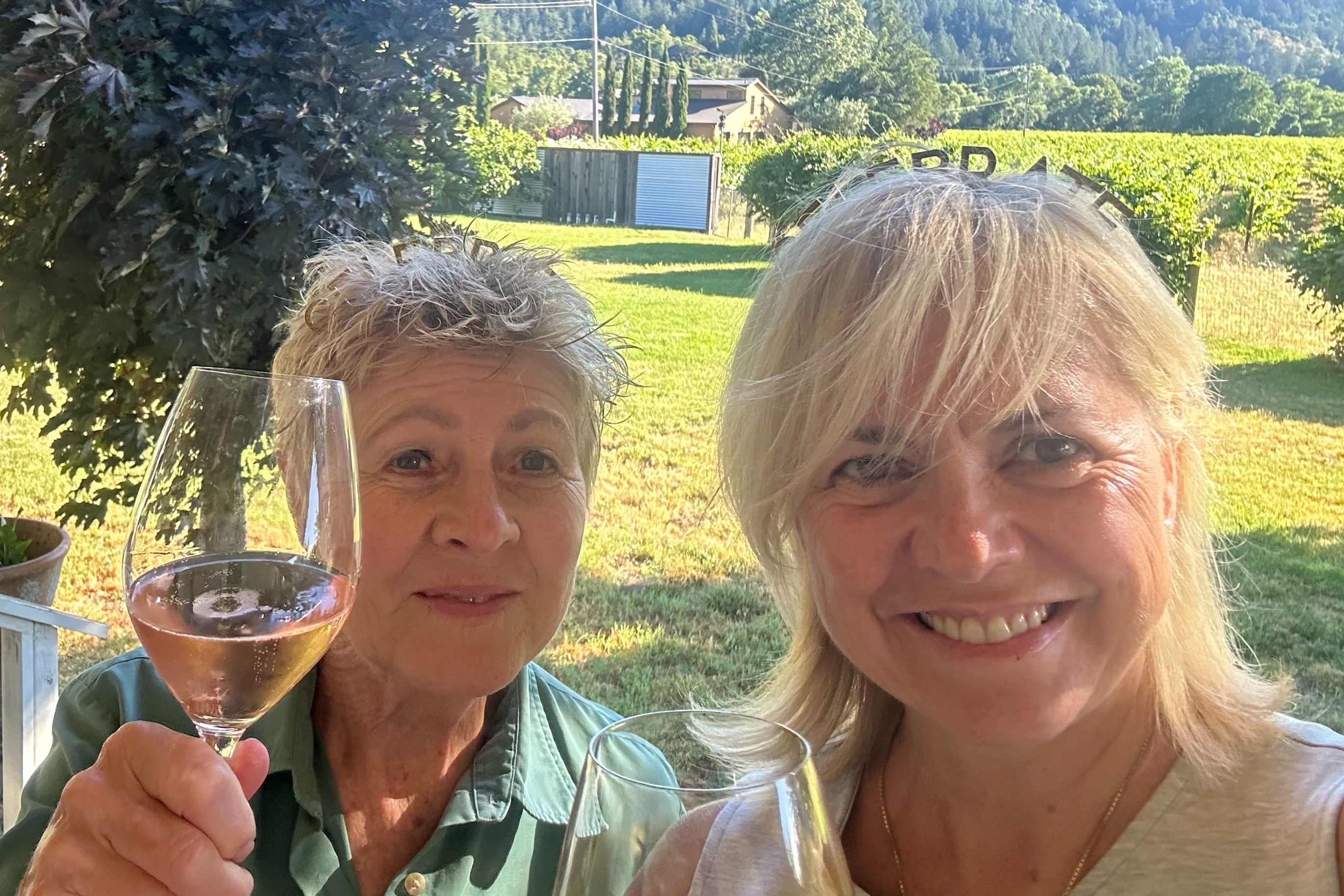
...and a special celebration with Amista Rosé de Tres
Rosés Have Exploded in Popularity
Dry, crisp rosés are surging in popularity across the U.S. Wine expert Liz Thach notes in Forbes that U.S. rosé sales volume skyrocketed by an incredible 1433% from 2010 to 2020. It seems I'm not the only one who loves rosés, especially as the weather warms and lighter foods dominate our plates.
What is Rosé Wine?
If you're reading this, you likely have some idea, but let's make sure we’re on the same page. Rosés, distinct from blush wines, are generally considered more premium. Those tracking rosé sales typically focus on wines priced at $7 and above per bottle, explicitly labeled as rosé. Like their European counterparts, these wines are dry.
How is Rosé Made?
Contrary to popular belief, rosé is not made by blending red and white wines. Instead, it is crafted entirely from red grapes using one of two methods:
- Limited Skin Contact: Red grapes are harvested and left to sit on their skins for only a few hours before pressing. This brief contact gives the wine its pink hue, unlike red wine, which develops a deeper color from extended skin contact lasting days, weeks, or even months.
- Saignée Method: Saignée, meaning "bleeding" in French, involves pulling juice from a tank of red grapes early in the maceration process when it is lighter in color. This lighter juice is then fermented separately as rosé. While some consider this method a byproduct of concentrating red wine, others use saignée intentionally to produce both red and rosé wines.
What Pairs Well with Rosé Wines?
Rosés pair beautifully with a variety of dishes. Here are some of my favorites:
- Steamed mussels with crusty bread
- Greek salad
- Chicken and avocado salad
- Grilled shrimp
- Linguine with pesto
- Thin spaghetti with cherry tomato and garlic sauce
- Seafood paella
Does Amista Make a Rosé?
Yes! Our Rosé de Tres is our current release, and it has quickly become my go-to wine for many recent evenings. Considered a Rhône-style rosé, as described by Wine Enthusiast, it is a blend of Grenache, Syrah, and Mourvèdre. Over our 20-year history, we’ve crafted several different rosés, starting with our first Rosé of Syrah, which came about serendipitously.
That initial wine inspired the creation of our first sparkling wine, Sparkling Syrah. Today, we offer four sparkling rosés: Sparkling Syrah, Sparkling Grenache, Sparkling Mataró (made from Mourvèdre grapes), and Sparkling Tres. But let's return to our Rosé de Tres.
What About Rosé All Day?
Our winemaker, Ashley Herzberg, often says she enjoys pairing our Rosé de Tres with a porch swing. It’s also perfect for the beach or lounging by the pool on a hot afternoon. Last Saturday, my friend Miriam and I enjoyed rosé—not all day, but all evening. The following Monday would have been my late husband and co-founder Mike’s 81st birthday, so Miriam and I celebrated in his honor. Mike’s favorite Amista wine was Tres, our red blend of Grenache, Syrah, and Mourvèdre, but on that hot day, I chose the Rosé version for his birthday celebration.
A Special Celebration - Cheers to Mike!
Miriam and I began our evening on the back deck where Mike and I used to sit in the same director’s chairs, watching the dogs play in the yard. It was a truly “sparkling moment” as we gazed out over the vineyards, the sun setting over the hills, with a glass of wine and a good friend. Miriam kept spreading her arms, looking at the view, and exclaiming, “This, this; need I say more?” We enjoyed simple hors d'oeuvres—roasted potatoes, cucumber wedges, and pita chips with a red pepper dipping sauce—that paired nicely with the rosé.
After a happy hour (or maybe longer, since we had a lot to catch up on), we put on our aprons and got to work. Miriam wore Mike’s Fire BBQ apron, which brought a small tear to my eye (I miss cooking with him). She made Mike’s favorite dessert, strawberry shortcake with a twist: chocolate shortcake, a variation he discovered several years ago. He served it for the first time at a breakfast meeting with winemaker Ashley, who has never forgotten the treat.
I was in charge of sautéing fresh corn and grilling salmon. Mike loved salmon and was a master at the grill; I am now teaching myself how to use it. The Rosé de Tres was amazing with the grilled salmon, offering fresh berry fruit, citrus notes, and wonderful acidity.
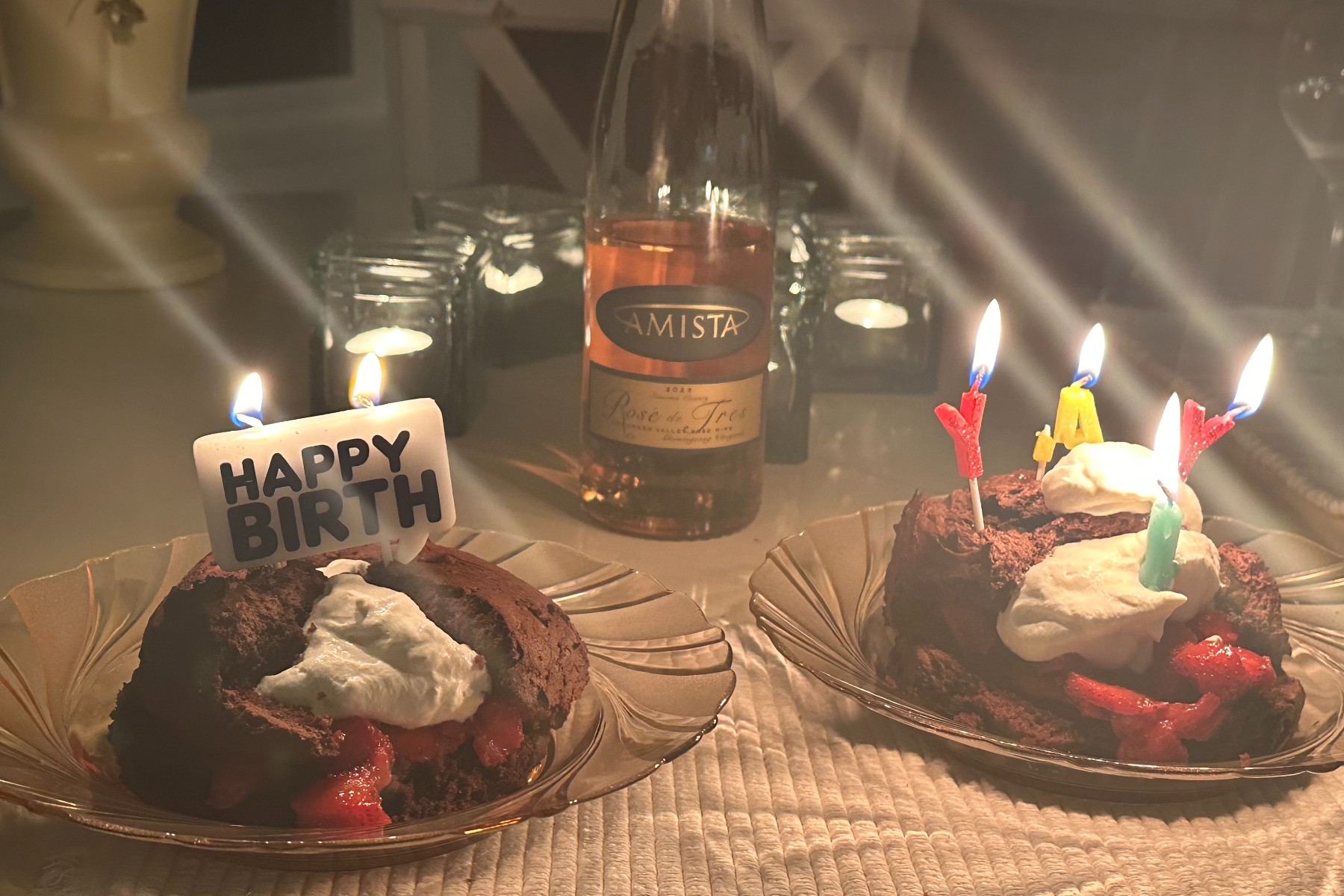
After dinner, we assembled our strawberry chocolate shortcakes, added candles, and proposed another toast to Mike’s birthday. The Rosé was with us the entire evening, a delightful companion to the back deck, the sunset, every course (including dessert), several toasts, and, most importantly, a precious friendship.
Still Thirsty?
If you want to learn more, here is a curated list of resources.
Hot Brands And Instagram Are Fueling Rosé Wine’s Phenomenal Growth Rate In The U.S. Market by Liz Thach in Forbes
A Quick Guide to Rosé Wine in Wine Enthusiast
What Do We Mean When We Say Rhône-style Wine? in Wine Enthusiast
Raising Our Glass to Mike Farrow, Amista Winemaker Emeritus and Co-founder, 1943 - 2023
Discover Rosé: What it is, how it's made, perfect pairings, and a special celebration with Amista Rosé de Tres in Healdsburg, California.
Raising our Glass to Mike Farrow
Mike Farrow (1943 - 2023)
It is with great sadness that we announce the death of Amista Vineyards co-founder Mike Farrow, who died at the age of 80 in hospice care on December 4, 2023. His wife and Amista co-founder, Vicky shared details of Mike’s health challenges in a blog post in August. Ultimately, he never fully recovered after contracting sepsis from an injury sustained during a fall earlier this year.
We will greatly miss his sense of humor, his warmth, and constant determination to find a way to turn challenges into creative opportunities. He was an inventive home chef and baker who enjoyed wine country living and sharing those simple pleasures with friends. We will always remember him so dapperly dressed in his tuxedo and top hat each year at our Sparkling Soirée.
Mike’s wife Vicky, Amista’s CEO, will continue to lead the winery and carry on the spirit of Amista with the help of their dedicated team. She invites those who knew Mike to come by the tasting room anytime to raise a glass in his honor.
It was Mike’s inspiration that led to the founding of Amista Vineyards with Vicky in 2004. The journey actually started in 1994 when he decided to plant 150 vines on their property in Saratoga, California, to solve a landscaping problem. Shortly thereafter, he started dabbling in making wine in their garage. Mike immediately fell in love with the alchemy of turning grapes into wine and sharing this love with others, including the many friends along the way who encouraged Mike and Vicky to found Amista. The winery name, as anyone who’s ever been to the tasting room knows, roughly means “making friends” in Spanish.
Mike retired to “Winemaker Emeritus” with the appointment of Ashley Herzberg as winemaker in 2011. Their friendship and collaboration over the years resulted in the expansion of Amista’s wine program, notably the planting of additional Rhône varietals and the creation of Mike’s favorite wine, a blend of Grenache, Syrah and Mourvèdre, which they named Tres. Ashley and Vicky ultimately persuaded Mike that they should launch what has become a growing portfolio of estate sparkling wines.
Next year will mark the 20th anniversary of Amista’s founding. It was always a great source of pride for Mike to have built a business that created friendships and connections, including helping to nurture career paths for many team members over the years.
Mike was born in 1943 in Boulder, Colorado, as the sixth in a line of eight boys to parents Mason, a chemist and Elizabeth, a teacher. After attending the University of Colorado Boulder and then going on to earn a PhD in chemistry from Oklahoma State University, he performed research and taught at the University of Utah, and then joined IBM as a research chemist. While at IBM he met Vicky, and they were married in Boulder in 1983. Mike is survived by his wife, his brothers Joe, Bob, and Tom, brother-in-law Chuck Goudge and many nieces and nephews, and his faithful shelties Torin and Dylan.
A celebration of Mike’s life is planned for the spring, and his legacy will be honored throughout 2024 as part of our 20th anniversary celebrations. We will share more details early next year, in the meantime, please come by for a special pour of Tres in his honor.
Cheers to you Mike, we tip our hats to you!
- Vicky and the Amista Team
Mike and Vicky have been longtime supporters of Sonoma County’s Career Technical Education Foundation. In lieu of flowers, donations can be made to support the foundation’s work to provide hands-on, career-connected learning opportunities to local students at https://ctesonomacounty.org/support-us/
The True Meaning of Amista
What I Discovered at the Vineyard Dinner
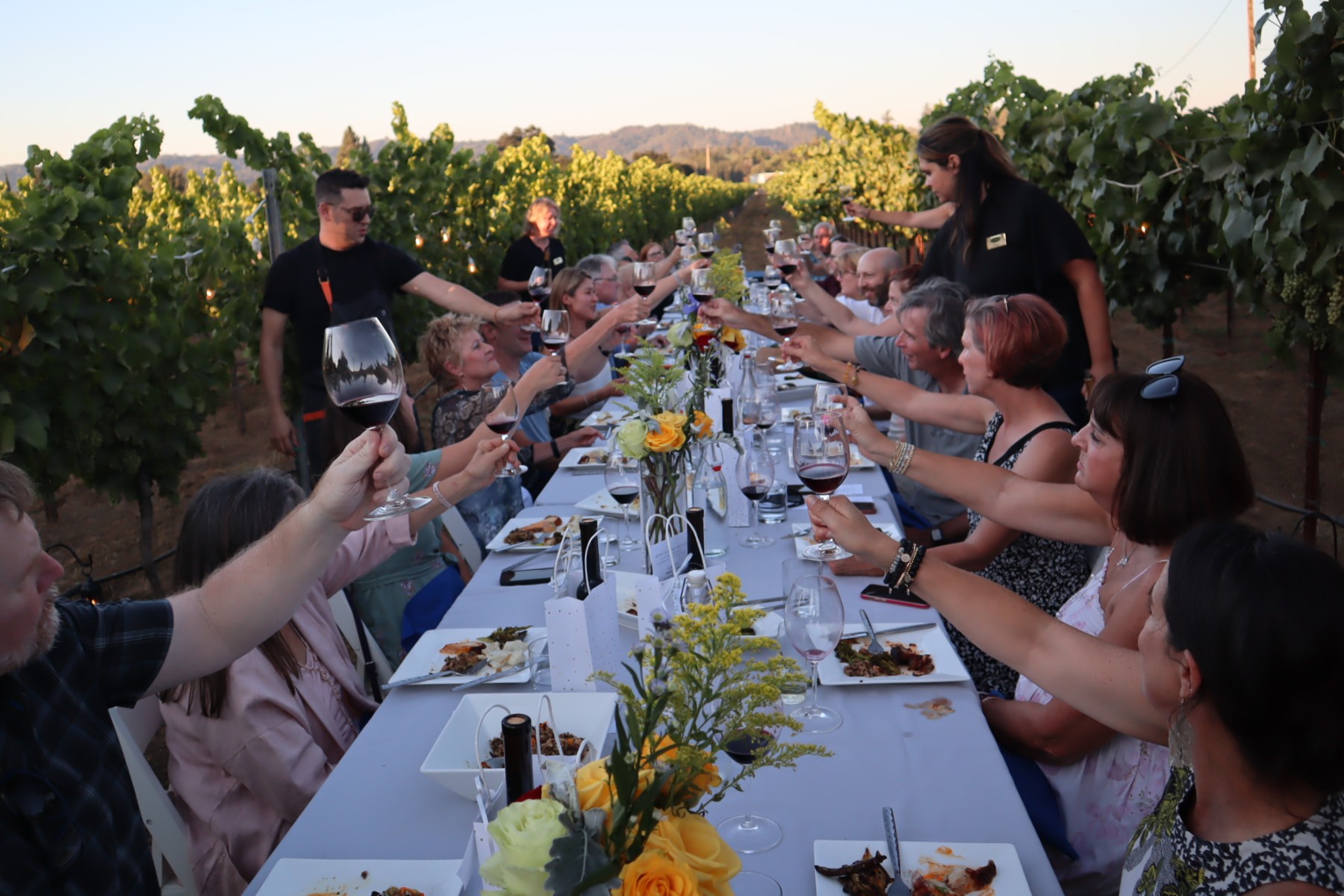
Friendship and Gratitude
Dinner in the Vineyard has always been a magical evening. This year was the first time that Mike was not able to join us. We drank a toast to him during dinner with his favorite wine, Tres.
I learned something very important that evening. I tried not to say much about Mike’s situation because it’s a festive occasion and who wants to hear about life’s trials and tribulations? And in fact, after a difficult day, sharing another amazing dinner among the vines with our guests lifted my spirits.
But I learned something more. I was touched when Jerry, a long-time club member, who makes the trip from Rhode Island each year, took the time during the vineyard walk to quietly ask, "How is Mike?" He genuinely wanted to know and didn’t seem to want just a cavalier “he’ll be fine” response.
Later in the evening, his wife Janie told me that they like to know about us and how we’re doing. She said that they feel more a part of the Amista family when they know what’s going on behind the scenes. During the fires, they appreciated our messages describing what was happening and they were relieved to learn we were not in the path of the fire.
So, for those who want to go behind the scenes, I will share more of the details of what our year has been like. Mike is currently in a rehab facility in Santa Rosa awaiting the replacement of his artificial knee. It’s been a rough year for him – a fall in mid-December where he wounded his knee, which led to a stay in the hospital over the holidays followed by two months of recovery at home with a 24/7 caregiver who moved in with us. It was necessary and needed but difficult for two introverts to share our small home with a stranger.
Just when Mike was able to get around on his own again, the wound on the knee became infected and he returned to the hospital at the end of March. He had surgery at Healdsburg Hospital where it was confirmed that the infection had gone to the bone and the artificial knee joint.
The artificial knee was removed and replaced with something called a spacer (basically cement) at UCSF, after which he spent 8 days in ICU to manage the sepsis infection. He was delirious for a few days and over a glass of wine I can tell you some hilarious stories! He returned to Healdsburg Hospital to complete six weeks of IV antibiotics and then transferred to a care facility in Santa Rosa. He is unable to walk because he cannot put any weight on the leg with the spacer.
The process has been much longer and more difficult than either of us imagined. The good news is that he finally has surgery scheduled on September 6 to get a new knee. He continues to get physical therapy while he awaits surgery, but it is limited since he cannot put any weight on the leg. He will return to the care facility for rehab, which will take longer than a typical knee replacement given his loss of muscle strength after spending so many months in bed.
Meanwhile, I have taken over full responsibility for our business – both the winery and vineyard – and our household, plus managing Mike’s healthcare (everyone needs an advocate to navigate the healthcare system) and driving to Santa Rosa to spend time with Mike each day. A bright light is that the dogs can visit him now that Torin has recovered from surgery and Dylan is improving after an injury to his leg during a frisbee run.
I am grateful that we have an incredible team led by Brian and an amazing winemaker and vineyard manager in Ashley and wonderful girlfriends who are there whenever I need something fun to do or a shoulder to cry on. And now I realize that there is a bigger community of Amista friends who are cheering us on. I’ll keep you posted.
With deepest gratitude,
Vicky
5 Surprising Facts About Grenache
All You Need to Know
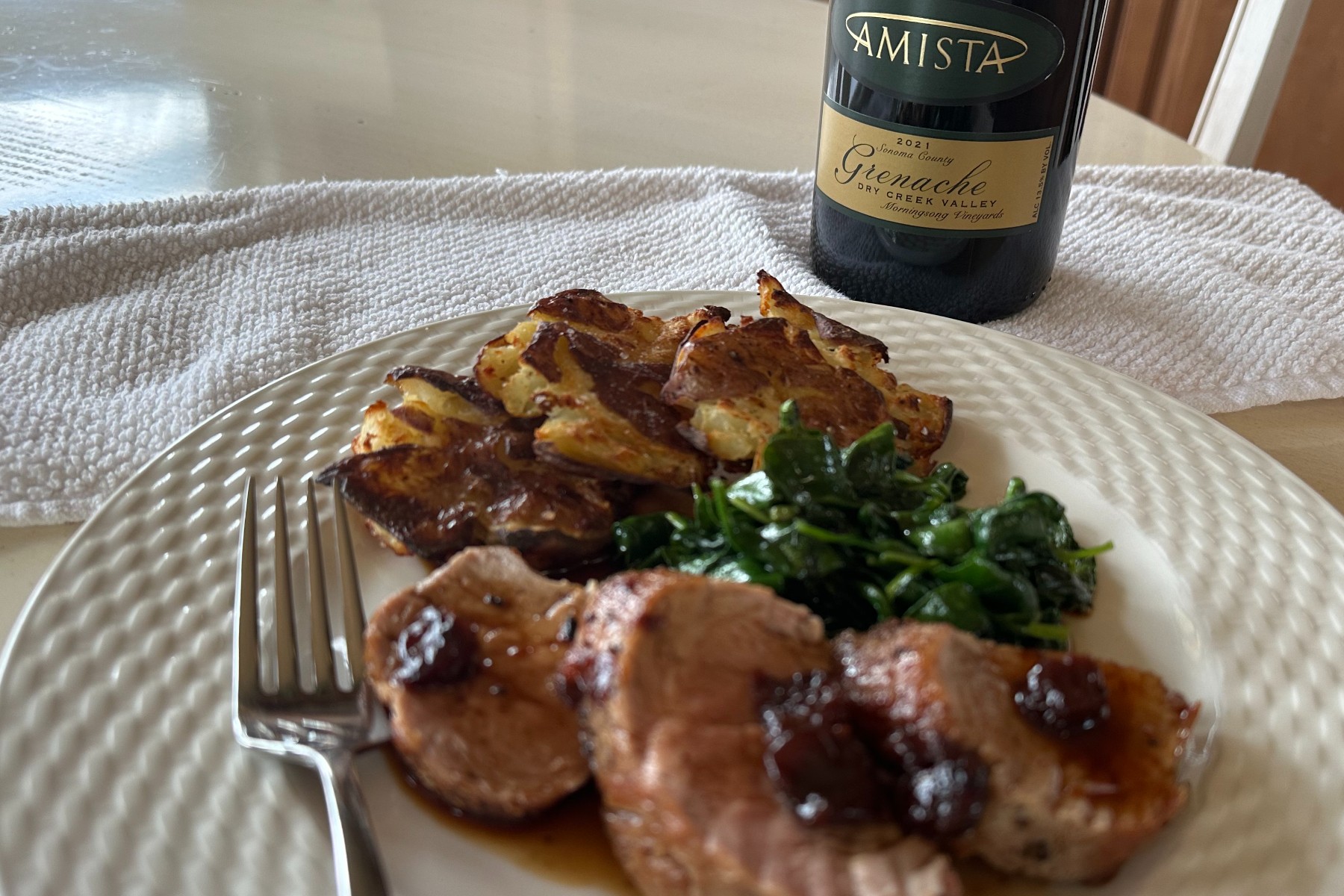
...plus a delicious Grenache pairing
Why care about Grenache, you might ask? Grenache has gained significant popularity and recognition in the world of wine. Its flavor profile appeals to a wide range of wine lovers and its medium body and medium tannins enable it to pair with a vast array of dishes and cuisines.
I have fallen in love with Grenache since we first added some to our estate vineyards in 2011. But what prompted me to write this post was a recent quote from a wine writer who attended the 40th anniversary celebration of the Dry Creek Valley AVA. Wine writer Mike Dunne proclaimed, “Forty years after federal authorities designated Dry Creek Valley an American Viticultural Area, the appellation’s signature wine has emerged – Grenache!”
That was music to my ears! We added our first Grenache vines despite the widely held opinion that Zinfandel was considered the signature grape in Dry Creek. I didn’t know much about Grenache then, but I knew I loved its medium body and that it was a great match for Mediterranean dishes, such as grilled meats, roasted vegetables, tapas, and even spicy foods – all the foods I love.
Pork tenderloin garnished with a raspberry balsamic sauce goes beautifully with Grenache. Add crispy smashed potatoes and sauteed spinach for a sensational taste experience.
5 Surprising Facts About Grenache
-
Grenache is the name in France; Garnacha is the name in Spain
-
Today Grenache/Garnacha is the 7th most planted grape in the world (5th among reds)
-
Grenache is one of the varieties in the renowned wines of the Châteauneuf-du-Pape AOC and has first billing in the trio of grapes that make up GSM blends (Grenache, Syrah, Mourvèdre)
-
Although often associated with France, it is widely agreed that Garnacha originated in Spain
-
Grenache is now referred to as a Rhône varietal, the world over
3 Interesting Tidbits about Grenache at Amista
- Today Grenache makes up 30% of the planted acres on our Morningsong estate vineyards
- Amista crafts the only Sparkling Grenache north of the Bay Bridge in California
- Grenache is used in seven of our Amista wines
Garnacha or Grenache?
Garnacha and Grenache are the same grape variety, known by different names in different regions. "Garnacha" is the Spanish name for the grape, while "Grenache" is the French name. The grape is believed to have originated in the region of Aragon in northeastern Spain.
While the grape variety itself is the same, there can be stylistic differences in the wines produced from Grenache depending on the terroir and winemaking techniques used in different regions. For example, Garnacha wines from Spain, particularly from regions like Priorat and Rioja, often exhibit a ripe, fruit-forward character with a touch of spiciness. Grenache wines from France, particularly from the southern Rhône Valley and Châteauneuf-du-Pape, can be more complex, showcasing a range of flavors including red and dark fruits, herbs, and floral notes.
A Widely Planted Wine Grape Variety
Although not as widely planted as Cabernet Sauvignon, Grenache/Garnacha is the 7th most planted grape in the world. Here are the top ten as of 2020 according to OIV (International Organisation of Vine and Wine).
Top grape varieties by planted hectares
1. Cabernet Sauvignon, 840,000 acres (340,000 hectares)
2. Merlot, 657,300 acres (266,000 hectares)
3. Tempranillo, 570,800 acres (231,000 hectares)
4. Airén, 538 700 acres (218 000 hectares)
5. Chardonnay, 518,900 acres (211,000 hectares)
6. Syrah, 470 000 acres (190,000 hectares)
7. Grenache Noir, 402,780 acres (163,000 hectares)
8. Sauvignon Blanc, 299 000 acres (121,000 hectares)
9. Pinot Noir, 285,000 acres (115,000 hectares)
10. Trebbiano Toscano / Ugni Blanc, 274,300 acres (111,000 hectares)
Grenache Plays a Starring Role in Châteauneuf-du-Pape
Grenache is one of the stars in the production of Châteauneuf-du-Pape wines and GSM blends. Châteauneuf-du-Pape is a renowned wine appellation located in the southern Rhône region of France. It is known for producing rich, complex, and full-bodied red wines that are highly sought after by wine enthusiasts around the world.
In Châteauneuf-du-Pape, Grenache is the dominant grape variety and is often the star of the blends. It thrives in the region's warm and sunny climate, where it can fully ripen and develop its characteristic flavors and aromas. It is accompanied by other varieties to create a harmonious and balanced wine. The most common blend, known as a GSM blend, consists of Grenache, Syrah, and Mourvèdre. Each variety brings its own unique characteristics to the blend, resulting in a wine with layers of flavors and a complex profile. The combination showcases a balance between fruitiness, spiciness, and structure. The wines are often full-bodied, with a silky texture, well-integrated tannins, and a long, lingering finish.
The Rhône Variety that Originated in Spain…or Italy
The origins of the Garnacha grape variety, also known as Grenache, have been the subject of some controversy and debate among wine experts and historians. While it is widely accepted that the Garnacha grape has Mediterranean roots, the specific location of its origin is still uncertain.
There are several theories regarding the origin of Garnacha. One theory suggests that Garnacha originated in the region of Aragon in northeastern Spain, where it has thrived for centuries, and it is home to some of the oldest Garnacha vineyards.
Another theory suggests that the grape may have originated in the region of Sardinia, Italy. Proponents of this theory point to genetic similarities between Sardinian grapes and Garnacha, as well as historical records that indicate the presence of Garnacha in Sardinia before it became widely established in Spain.
Grapevine cultivation and trade have taken place across the Mediterranean for thousands of years, making it difficult to pinpoint the exact origin of many grape varieties. Genetic studies have shed some light on the relationships between different grape varieties, but they have not definitively settled the debate about Garnacha's precise origin.
Today Grenache is Known as a Rhône Variety
Ironically today Grenache is known as a Rhône variety. This is due to its historical and significant cultivation in the Rhône Valley of southern France. The Rhône Valley is renowned for its production of red wines, and Grenache has been growing there for centuries. I wonder if it also due to the fame of Châteauneuf-du-Pape, which has no such rival in either Spain or Italy.
Still Thirsty?
If you want to learn more about Grenache, here is a curated list of resources.
Three Novel Ways to Celebrate National Wine Day
How about throwing a wine party with a new twist...
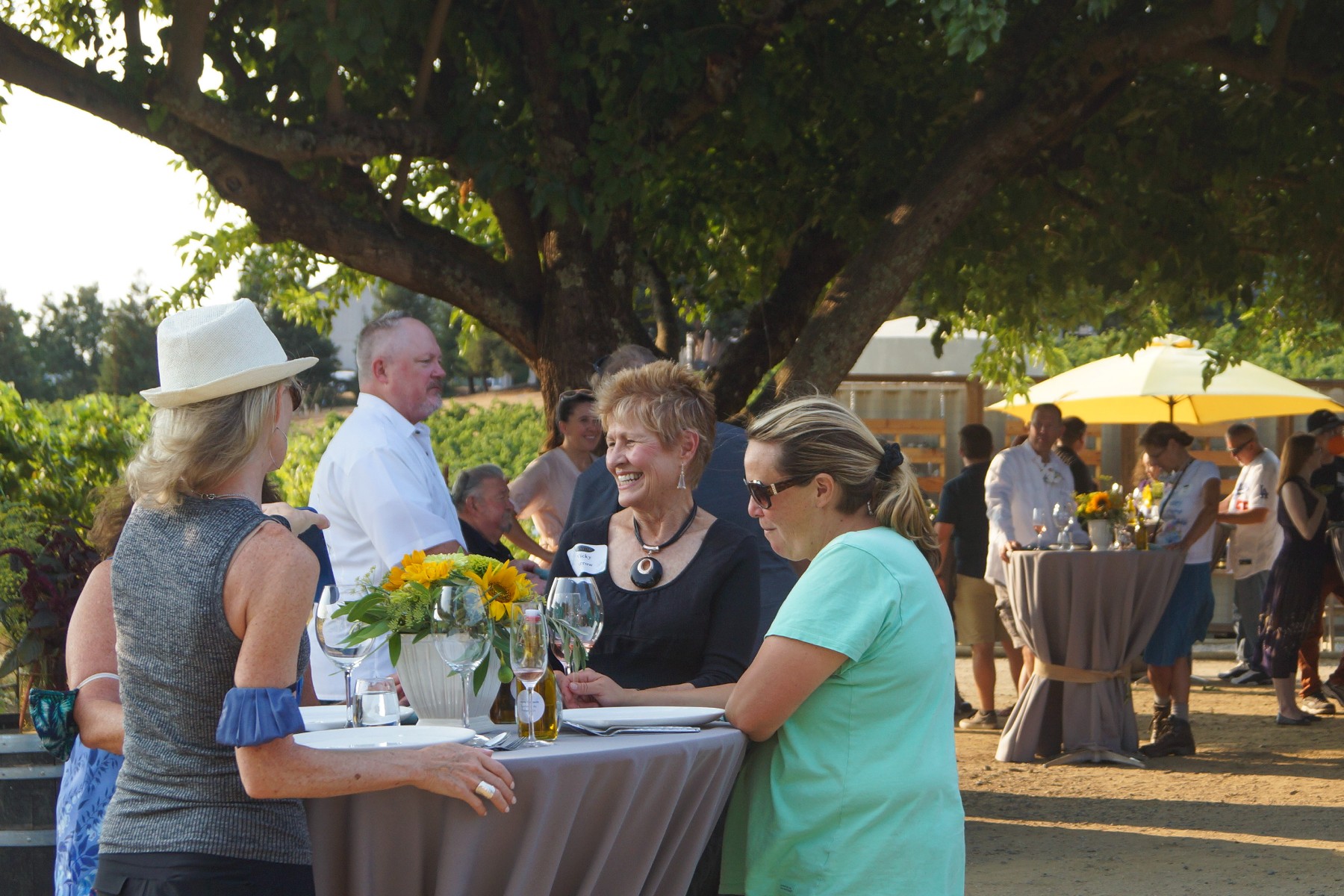
...that is sure to delight your wine-loving friends!
Did you know that National Wine Day is coming up this month on May 25? It is the perfect occasion to raise a glass to celebrate the exquisite flavors and aromas of wine. At Amista – which roughly translated means “making friends” in Spanish – we think the best way to celebrate is with friends. If you're looking for novel ways to commemorate this special day, here are three parties designed to explore the rich tapestry of wine with your special group of wine-loving friends.
Host a “You Aren’t Going to Believe This Great Wine I Found Party”
Gather your wine loving friends, family, or colleagues to celebrate National Wine Day by hosting a wine tasting party. But let’s kick it up a notch and ask each guest to bring an unusual wine they’ve discovered and come to love. It could be an obscure variety, an unusual style or from an unexpected part of the world. Each guest takes a turn telling the story of how they discovered their special wine and why they love it. Then everyone has a taste.
Such a party needs some equally interesting nibbles. Of course, there is the usual cheese and charcuterie spread, which is always welcome. But a “You Aren’t Going to Believe This Great Wine I Found Party” demands a twist. At Amista, we serve freshly popped popcorn. It’s so popular that when our popcorn machine broke one day, our guests went on strike.
We use a lemon-herb salt which showcases our sparkling Blanc de Blanc. To make it work for your party, assemble an assortment of at least a half dozen spice blends that can be sprinkled on the popcorn – a kind of popcorn bar. Choose a variety of blends that go with different wine flavor profiles. It’s novel, it’s easy and it’s fun to see what herbs and spices pair with each of the wines.
If I were going to the party, I would bring our Amista Sparkling Syrah. This wine never ceases to amaze people. Its cranberry color fools them into thinking it’s going to be sickly sweet and yet it’s quite dry – always Extra Brut (6 grams of sugar per liter or less). Also surprising is that it goes so well with diverse foods from Thanksgiving dinner to sushi to Peking duck. It even works with panna cotta and raspberry coulis! And the interesting tidbit is that we would never have made it if it weren’t for a class project at our local junior college.
If you want to create a delightful ambiance to celebrate National Wine Day, throwing a “You Aren’t Going to Believe This Great Wine I Found Party” will do the trick. The wines, the personal stories and the popcorn bar will provide a rich backdrop for exploring new wines, flavor combinations and conversations among friends.
Throw a “My Favorite Winery Party”
The invitation list for this party requires that your guests have a favorite winery they have visited in person. If you don’t have any friends who have visited a winery in person, I would say you need to make some new friends! But if you’re reading this blog post, you undoubtedly have friends who have gone wine tasting, so I’m assume you’re good to go. Invite them to celebrate National Wine Day with you by bringing any bottle of wine from their favorite winery.
Have each guest describe the wine they picked and why this is their favorite winery. Then everyone gets a chance to taste the wine. I suggest you start with the guests who brought sparkling wines, then whites, followed by rosés and then reds, from lighter to heavier in body, and ending with dessert wines.
It’s always good to have snacks when you’re tasting a lot of wine. It can be something very simple but tasty like bowls of kettle chips, popcorn, pretzels and nuts. You can also add a selection of cheeses, charcuterie and dried fruits.
If I was invited to such a party, I would proudly bring an Amista wine and it would have to be my go-to bubbly, our Amista Blanc de Blanc. This is the wine that marks the end of my workday and the beginning of my evening. It frequently continues as the wine that accompanies our dinner since we often have a fish dish or light pasta, which makes an amazing combination.
Hosting a “My Favorite Winery Party” allows your friends to share (and re-live) the wines and experiences they have savored on their wine journey. Celebrating wine is more than the wine itself. It’s the stories; it’s the experiences; it’s the landscapes; it’s the people that we remember when we visit a winery. Very often those moments are experienced with friends and create a lasting memory of shared happiness and joy.
Organize a “Bring Your Own Best Pairings (BYOP) Dinner Party”
National Wine Day presents an excellent opportunity to elevate your culinary experiences by pairing wines with delicious dishes. Whether your friends are seasoned chefs, enthusiastic home cooks, or discerning takeout experts, the versatility of wines allows for exciting pairings. Ask each guest to bring a dish and a wine that exemplifies their perfect pairing. You can assign hors d'oeuvres, first courses, entrees, sides and desserts. Or if you feel especially adventurous, you can leave it all to your guests and be prepared for a surprise!
Much like a winemaker dinner, have each guest describe their dish and the wine they chose for the perfect pairing before the dish is served. Hopefully there will be enough food and wine to try some of the dishes with different wines. Who knows, perhaps an even more perfect pairing will be discovered!
My perfect pairing would be a classic French cassoulet with our Amista Syrah. I adore beans – go figure - but when you combine them with chicken, duck confit and sausage and cook them slowly for hours with a crust of crispy breadcrumbs, well, I’m in heaven. And while I often describe our Syrah as a crowd pleaser, the perfect wine to take to a dinner party because it works with so many dishes, the cassoulet elevates it to a whole new level and vice versa.
The “Bring Your Own Best Pairings (BYOP) Dinner Party” is a unique variation on a classic winemaker dinner. It’s a way for everyone to channel their inner winemaker and inner chef and experience the varied tastes of a whole group of friends. What better way to celebrate the spirit of National Wine Day.
National Wine Day provides an excellent opportunity to appreciate the artistry of winemaking and the distinctive flavors of wines from around the world. Although seriously, there's no need to wait for a special day. You can choose any day to raise your glass and toast to the pleasures of fine wine, good food and dear friends. Cheers!
You're invited to explore the sparkling wines and Rhône varieties at Amista. We hope we'll become your new favorite winery. Come Taste With Us!
Does Color Matter in Sparkling Wine?
For the Fan Favorite, Sparkling Syrah...
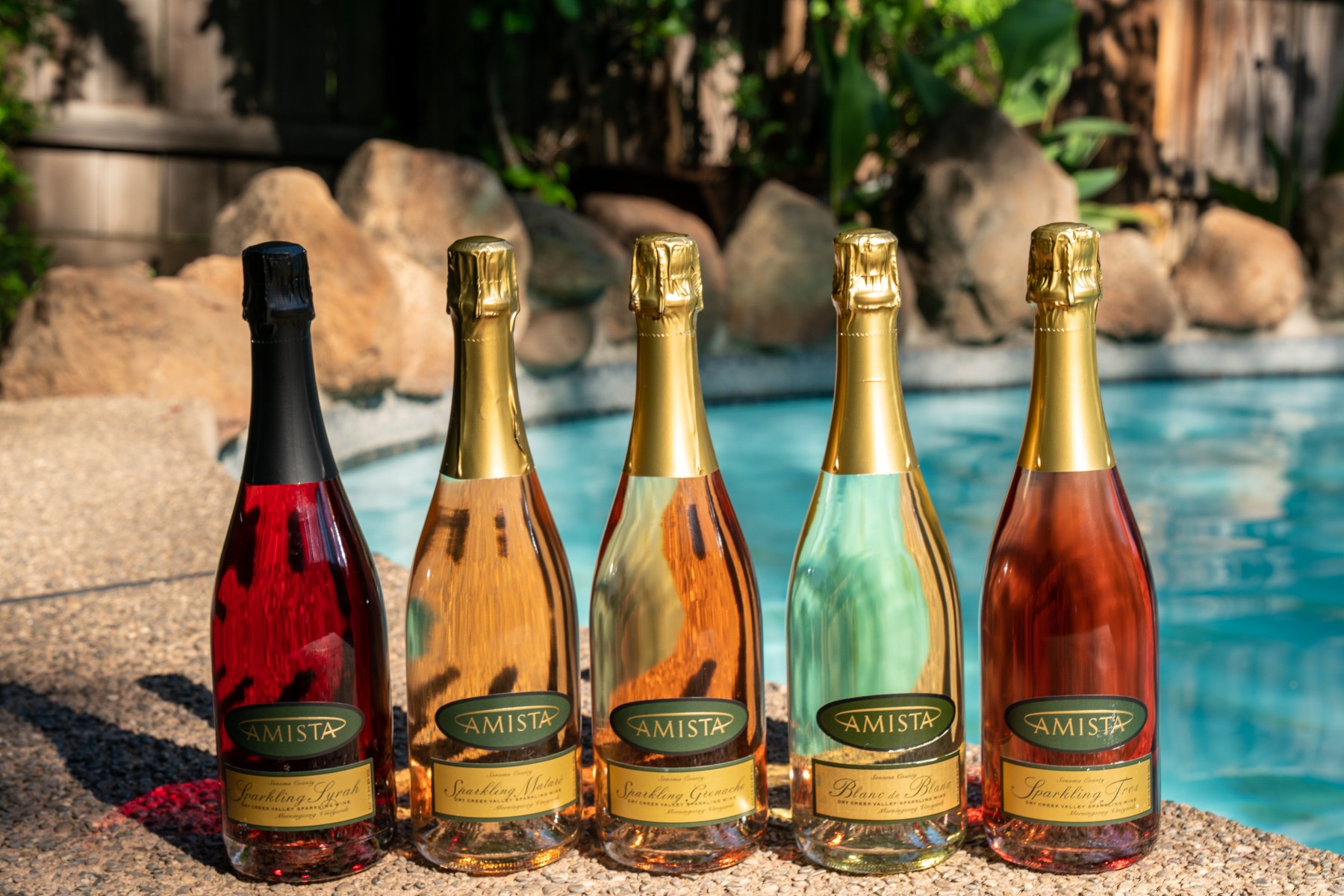
…will it be color or flavor?
Does Color Matter?
This is the question we went round and round about during our most recent dosage trial for our Sparkling Syrah. In fact, this was our second dosage trial for this wine because during the first trial, we all agreed that the color of the wine was too light. The colors of all our sparkling rosé wines vary a little from year to year. Nevertheless, the Sparkling Syrah is typically cranberry in color.
This Sparkling Syrah Was Not the Usual Cranberry Color
This one was more of a coral color. It’s beautiful in the glass and the flavors are delightful. It just looks different than what we or our members are used to. So, after our first trial, winemaker Ashley Herzberg decided to go back and try adding a small amount of still Syrah to the dosage. She brought a 1% and a 2% addition. We all liked the look of the 2% addition in the bottle. It was still a bit lighter than usual and leaned more toward coral than cranberry, but it was closer to the color we’ve all come to expect.
Always Cranberry, Except for the “Dark Year”
That was the 2010 vintage, before the other members of our team had joined us. Ashley, Mike and I remember it well. The “dark year” was alluring in the bottle but to our taste, it had just a little too much of the earthy flavor of Syrah. We love that flavor in the red Syrah. In our sparkling rosé we want a brighter, more fruit forward flavor.
But How Does It Taste?
OK, so back to the dosage trial. After seeing the colors of the two different additions in the bottle, it was time to pour and taste. We poured the 1% and 2% additions and looked at them side by side. In the glass, the differences in color were more subtle, although all of us preferred the color of the 2%. Now for the tasting. As soon as we tasted I got that hint of earthy Syrah in both samples. I didn’t want to say anything but then Ashley mentioned it. We decided we needed to go back and try the original without any added Syrah.
We were all blown away with how much fresher and fruitier it tasted, with bright bubbles on the tongue. The Syrah addition had weighed the wine down a little. The wind went out of our sails because we loved the taste of the original and preferred the color of the 2% addition.
What Do Our Customers Expect?
A lively discussion ensued about how much fun it is to do a tasting for our guests and start with a splash of our Blanc de Blanc, then proceed to one of the lighter rosés and then unveil the cranberry colored Sparkling Syrah. We call it “joy in a bottle” and it brings a festive note to, not only to a tasting, but to any occasion or dinner table.
Then we had an in-depth conversaton about our club members. We have many who have been members for years and they remember the colors of our different sparkling rosés. That is in part because all our sparkling wines are bottled in flint (clear) glass, so the color is visible. The other is that we have several rosés – many sparkling houses have only one. We’ve made a point to craft them so they each have a slightly different color. Now our members have come to expect that. Did something we featured come back to bite us?
Why Is It So Hard to Get a Specific Color?
From a winemaker’s perspective, achieving just the right color is no small feat. First, you don’t always have complete control of how much time the grapes stay on the skins, which is what imparts the color. Second, sometimes you get just the right color when you press the fruit and then it falls out when you disgorge the wine. You can adjust the color by adding some of the still red wine during the dosage, but that may change the flavor profile.
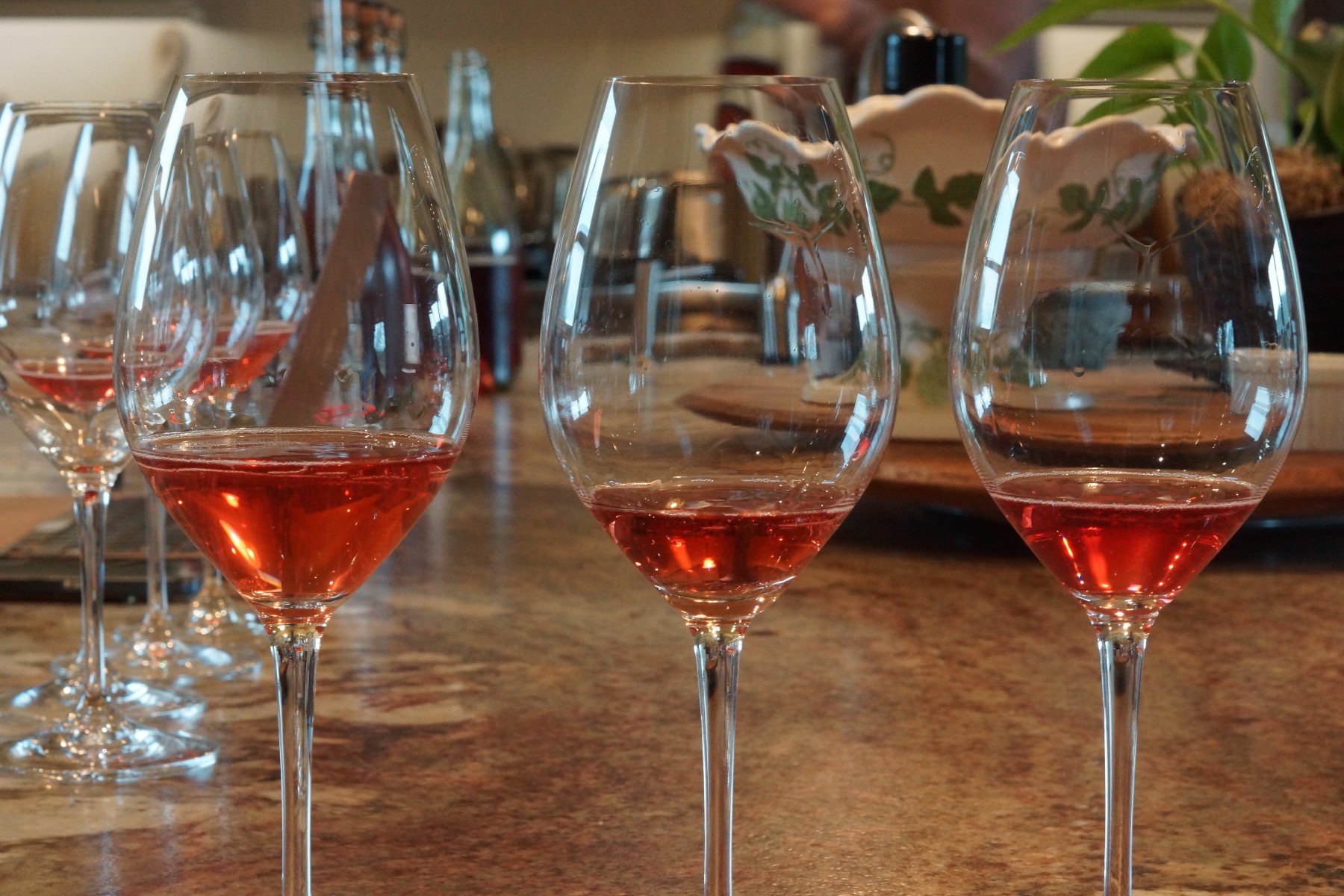
What Did We Decide – Color or Flavor?
It was unanimous. Taste wins over color. As much as we wanted the deeper, cranberry color, we just couldn’t sacrifice taste. Perhaps it’s not the cranberry color that makes our Sparkling Syrah “joy in a bottle”. I’m convinced that in a blind taste test, the joy would come from the bright, fresh picked strawberry flavors with a hint of citrus that bursts on the tongue.
Treat yourself to a little "joy in a bottle". Try our sparkling wines and Rhône varieties. Come Taste With Us!
Celebrating Sparkling Women in History
From Veuve Clicquot to Amista’s Ashley Herzberg
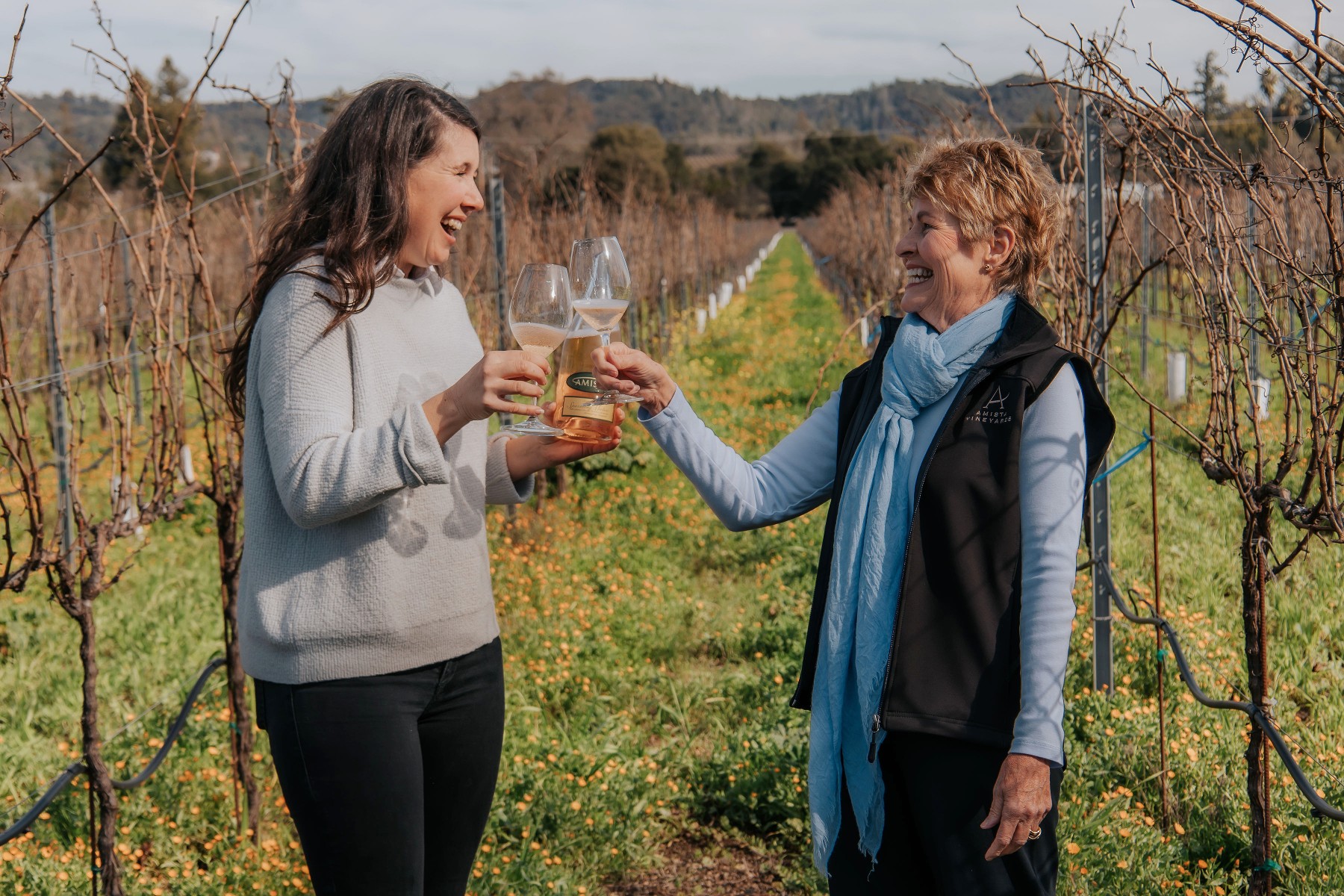
…a toast to the women of sparkling – past and present
I just read an excellent article titled “How three widows came to rule Champagne” about the women who created some of Champagne’s most lauded empires. Although women were restricted from owning a business without the permission of their husband or father in 19th century France, widows were exempt from this rule.
Female Ingenuity in Champagne
“Some of the biggest innovations of Champagne came down to the ingenuity of several women…Barbe-Nicole Clicquot-Ponsardin, Louise Pommery and Lily Bollinger – among others – to turn vineyards into empires and ultimately transform the Champagne industry, permanently changing how it's made and marketed,” writes Lily Radziemski in BBC.com's World’s Table.
Bold Actions by Three Widows
It is good to be reminded of some of the bold actions of these three Champagne widows such as running the blockade into Russia to beat her biggest competitor to market before the borders opened, dramatically reducing the dosage (residual sugar) in her Champagne from the typical 300 grams per liter to what is now called Brut (12 grams or less) to appeal to the British market, or traveling alone across the U.S. to hand sell her Champagne to the American market.
Drawing Inspiration from Women's History Month
I’m inspired by these women who ignored what was considered acceptable for women at the time and daringly stepped in to manage and ultimately transform the businesses they inherited. “The independence and creativity of the three widows paved the way for generations of women to come,” explains Radziemski.
Paving the Way for Today's Women in Sparkling
The conversations I have with women leaders in sparkling wine prove her point. I continue to be inspired by the women who are blazing new trails in today’s business world. I enjoy the great privilege of having in-depth conversations with some of today’s female leaders in sparkling wine through my new project, Sparkling Discoveries. [We include men as well, but given that March is Women’s History Month, my focus is on women in this post].
Eileen Crane was hired as the winemaker for Gloria Ferrer, the first sparkling winery in Carneros, and discovered that in addition to making the wines, she would be responsible for constructing the winery and visitor center and launching the new brand. She went on to lead Domaine Carneros, starting one of the first wine clubs, pioneering the installation of solar at a winery and practicing “open book management.”
Penny Gadd-Coster became a sparkling winemaker after two previous careers – one in research and the other in hospital emergency rooms. She was told countless times that she could never become a winemaker because, “People didn’t think women should be in the cellar. The work was too physical,” explains Penny. She went on to be the Executive Director of Winemaking at Rack and Riddle, a custom wine services operation that produces wines for hundreds of sparkling wine houses.
Joy Sterling, owner of Iron Horse Vineyards, had a successful career in broadcast journalism until on her 10th anniversary she abruptly quit her job and moved to Sonoma County with no plan and no experience, to join her family’s sparkling wine business. She has become a master at creating new sparkling wines, often contributing part of the proceeds to causes that are dear to her heart such as the Marine Mammal Center (Ocean Reserve) and Redwood Empire Food Bank (Gratitude).
And speaking of close to the heart, I am fortunate to work alongside our woman winemaker at Amista, Ashley Herzberg, for the last 12 years and counting! She a trailblazer when it comes to winemaking, being the first woman to make a “grower sparkling wine” in Dry Creek Valley. She also manages to juggle being a busy winemaker, harvesting from multiple vineyards, working in several production facilities, making still and sparkling wines and attending numerous wine events, with being a dedicated mom to her two children. I am especially inspired by how she weaves together her work, her family, her friends and her community into a seamless life of constant learning, passion and delight.
Ashley and I are honored and proud to be part of a growing community of wineries in Sonoma County that are female led with female winemakers.
Read “How three widows came to rule Champagne”
Check out more Sparkling Conversations with other interesting people from the world of sparkling wine.
Amista Wine - How We Fell in Love with Sparkling Rhône Varieties
Let’s Start with a Sparkling Syrah!
The very first sparkling wine we made was from a Rhône grape – a Sparkling Syrah – and we’ve been making it since 2008. Technically it is a rosé of Syrah because it spends only a few hours on the skins before being pressed off. It is a gorgeous cranberry color. It’s festive. It shimmers in the glass. I call it ‘joy in a bottle’.
But Winemaker Ashley Herzberg wasn't so sure. She received two bottles as a gift from my husband Mike before she became our winemaker. She stuck it in her closet thinking it would be icky and sweet. One night she pulled it out to serve to her girlfriends - a good way to get rid of it. They immediately started raving about it, so she took a taste. She became a convert and has been making and sipping “joy" ever since.
Our current release has aromas of black cherry, roasted strawberries and cream, toasted almonds and a hint of ruby red grapefruit zest. The front palate is bright and filled with berry notes. The finish has great acidity and balance with a slight savory character that makes it deliciously food friendly. The finish is beautiful and lingering.
Sparkling Syrah Pairs Beautifully with Spicy Foods
One thing we’ve learned about Rhône-style wines is that they pair beautifully with a wide array of foods. The Sparkling Syrah is a perfect example. It is especially at its best with spicy foods, from Thai, to Indian to Mexican. It is also right at home on a holiday table because it has enough body to stand up to the vast assortment of flavors that are part of the feast and provides a refreshing counterpoint to the rich dishes that are typical of holiday celebrations.
Winemaker Ashley says the most interesting pairing she has had with a sparkling wine was the Sparkling Syrah with Peking duck roasted in a wood burning oven. “I was surprised because I don't love duck. It's not my cup of tea, but the Sparkling Syrah cut through the richness of the duck and just sort of brought it to another level and I was like, oh, duck needs something acidic to brighten the flavors,” explained Ashley.
Syrah was among the first wines we made when we launched Amista Vineyards. It has always played a big role in our wine program. We planted Syrah on our estate Morningsong Vineyards in 2000, and although we didn’t have much experience drinking Syrah, we quickly fell in love. It is a very drinkable wine without the heavy tannins of a Cabernet or the big jammy flavors or a Zin.
Bring on More Rhône Varietals
In 2011 we added two more Rhône varietals to our estate vineyards, Grenache and Mourvèdre. That enabled us to produce a Grenache, a Mourvèdre and a Rhône-style blend we called Tres, to stand beside our flagship Syrah. Tres was our first blend and it quickly became my husband Mike’s favorite, and my second favorite after anything sparkling! Tres is the wine I would take to a dinner party knowing that it would please any palate and drink well with nearly any dish.
Let’s Make Another Sparkling Rhône
So, you can see that we came to plant, make and love red Rhône varietals. But winemaker Ashley and I love bubbles and she wanted to make sparkling wine from the Grenache. I was all in! I can still remember the first taste of the still Grenache rosé that would eventually become a sparkling wine. Ashley took it right from the tank and the wine was gorgeous in the glass – a pink blush color – and even more gorgeous to taste. We both knew immediately that this would be an incredible sparkling wine. Wine Business Monthly agreed, selecting it as one of 10 Hot Brands the year it debuted.
Five Sparkling Rhône-style Wines in Our Collection!
Today we have five sparkling wines made in whole or in part from Rhône varieties. In addition to our Sparkling Syrah, which has become a cult favorite, and our Sparkling Grenache, which sells out every year, we have Sparkling Mataró (made from 100% Mourvèdre grapes), Sparkling Tres (a blend of Grenache, Syrah and Mourvèdre) and Fusión (a blend of Chardonnay – which is not a Rhône grape – with Syrah and Grenache).
Treat yourself and explore our Rhône-style sparkling wines.
What is the Best Amista Wine?
How We Fell in Love with Red Rhône Wines
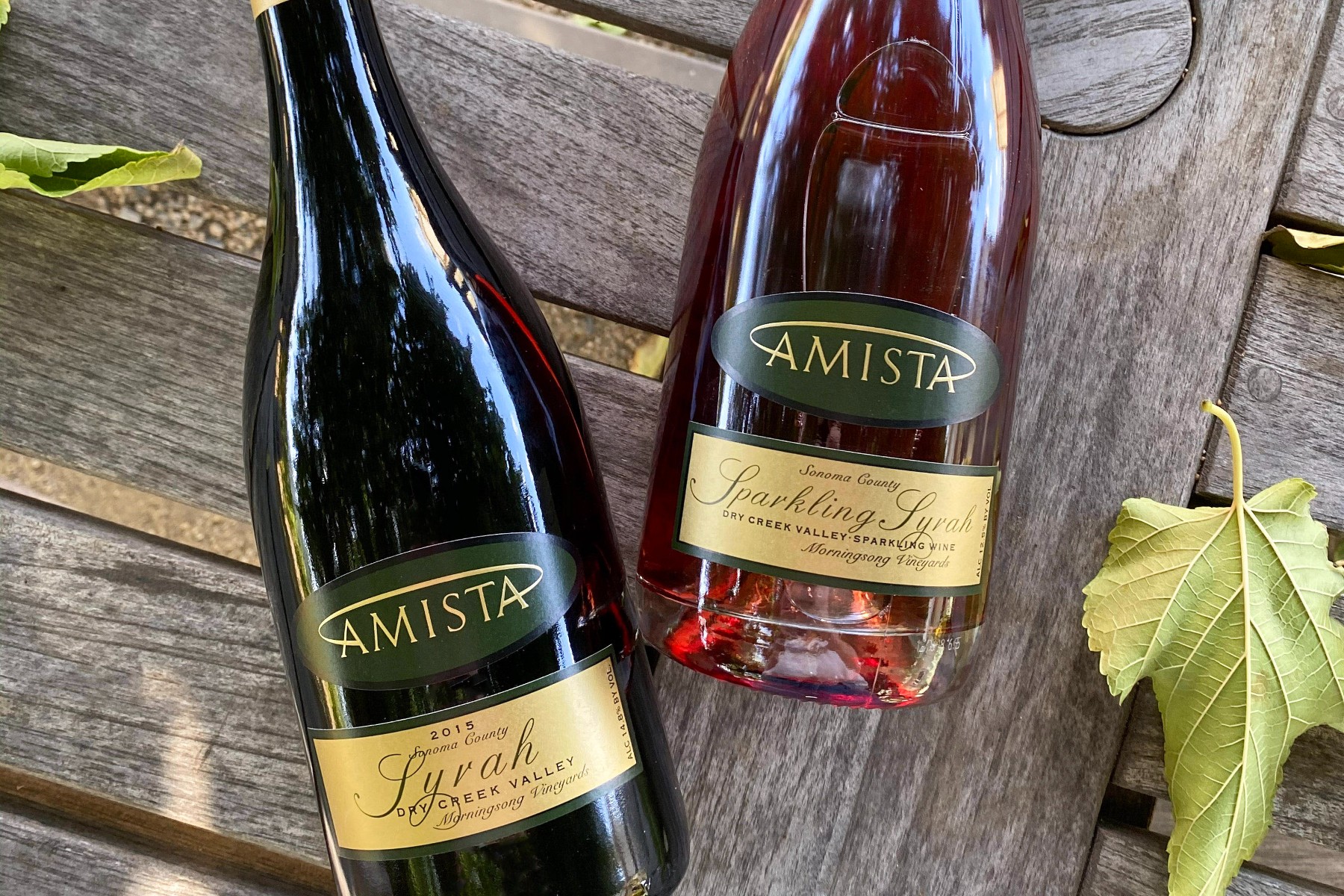
…but why stop at red when you can make sparkling?
The first wine we made from our Healdsburg property was a Rhône variety, namely Syrah. We had just moved to Healdsburg and the Syrah vineyard we planted was only two years old. We’re not really sure why we planted Syrah except it was supposed to be an up-and-coming variety. That was just before the movie Sideways made Pinot Noir famous. Syrah was relegated to the wings while Pinot Noir took over the starring role in the California red wine show.
Garage Syrah
But I digress. Traditionally, the grapes of a two year old vineyard would be dropped on the ground to allow the roots to take hold without the burden of producing a crop. But husband Mike had other ideas. After having made his first wine almost 10 years earlier in our Silicon Valley California home - before our detour to New Jersey and Nevada - he was eager to make wine again. In 2002, he harvested three tons from the young Syrah vines and made wine in our garage with the help of neighbors, family and friends from Munich and Denver. We called it “Garage Syrah”.
The Launch of Amista
This was the wine that seduced us into starting Amista. The Garage Syrah was a hobby wine, made only for personal consumption. But every time we invited friends to come taste from the barrel, they loved the wine and wanted to know if they could buy some once it was bottled. Our friends eventually talked us into making wine for sale and Amista Vineyards was born in 2004.
Even though Syrah has not (yet) become “the hot variety”, we have fallen in love with it. So have our guests and members. We use it in many of our wines and it was the “gateway” grape that got us into Rhône varieties.
We Want More Rhônes!
In 2011 we decided to replace some of the Syrah vines. We were anxious to experiment with other Rhône varieties. Rather than rip out the 11-year-old vines, we used a technique called T-budding, where a T-shaped cut is made and a bud from the new variety is placed in the graft. We grafted about an acre each to Grenache and Mourvèdre. Another advantage of grafting is that you don’t have to wait four years for the vineyards to produce a crop. By the harvest of 2012, the new vines were producing a small amount of fruit and we made our first Grenache and a blend we call Tres, composed of all three of our Rhône grape varieties, Grenache, Syrah and Mourvèdre.
Debut of Our First Rhône Blend
Tres was an instant hit and became Mike’s new favorite. It was the first blend we made on purpose (our dessert style wine was technically our first blend, but it started out as a Zinfandel that would never go dry – a story for another day). A major impetus for doing a blend was winemaker Ashley Herzberg, who had joined us in 2011. Our wines had always been single varietal from a single vineyard. That was what we did. But winemakers love to do blends and Ashley patiently talked us into making a GSM-style blend (Grenache-Syrah-Mourvèdre). Mike was prepared not to like it and it is now his go-to wine.
The Amista Wine Lineup – Focus on Rhônes
We now make four red wines from our estate-grown Rhône grapes: a Syrah, a Grenache and a Mourvèdre, plus Tres, our Rhône-style blend. In addition, we make two Rosés from our Rhônes: Rosé de Tres and Rosé of Grenache.
Why Stop at Red When You Can Make Sparkling?
Becoming the first sparkling winery in Healdsburg wasn’t part of our plan, although to be honest, in those days we didn’t really have a plan. It all started when we made our first sparkling wine in 2008, just five years after our first Amista harvest in 2003. Once again, Syrah was the star of our show.
Our first Rosé was made from Syrah and had become a big hit. In 2007, Chris (our consulting winemaker at the time) asked if he could have some of the current vintage of our Rosé of Syrah to use to teach his class at the junior college how to make a sparkling wine using the classic Methode Champenoise. This is the method used to make fine French Champagne. We immediately said yes, on the condition that we got to try the finished product.
When we tasted it, we knew we had to make more for ourselves and our friends. We sent one barrel each of our 2007 and 2008 Rosé of Syrah, to a custom crush winery specializing in sparkling wines. This is where the second fermentation in the bottle was done, transforming a still wine into a sparkling wine. We released it in 2009 at our first Sparkling Holidays party. Mike celebrated the occasion with what has now become a tradition at this party of opening the bottle with a saber.
Sparkling Wines from Non-Traditional Grapes
Our first sparkling wine was made with a grape that is never used in classic French Champagne, Syrah. Traditionally, Champagne and sparkling wines are made from Chardonnay and Pinot Noir grapes. The Australians make a bubbly called Sparkling Shiraz from the Syrah grape, but it is a very deep red color and slightly sweet. Our Sparkling Syrah is a rosé, glittering cranberry in color and quite dry.
Most of the grapes we grow on our own vineyards are Rhône varieties – Grenache, Syrah and Mourvèdre. Using those grapes rather than the classic Champagne varieties, is one of the ways we innovate. The other non-traditional approach we take is to produce sparkling wines from single vintages. Although we don’t vintage date them, each bottling comes from a single year (except that first Sparkling Syrah). Most Champagnes and sparkling wines are blends from several vintages. We have the luxury of beautiful California weather, so we don’t need to save the “good years” to blend with the bad.
We now have three sparkling wines made from single Rhône grapes: Sparkling Syrah, Sparkling Grenache, Sparkling Mataró (made from 100% Mourvèdre), plus two blends that are made in whole or in part from Rhône varieties: Sparkling Tres and Fusión (a blend of Chardonnay, Grenache and Syrah).
So, what is the best Amista wine? There is no one answer. We have fallen in love with Rhône wines, and we love them all. As a friend is fond of saying, “My favorite Amista wine is the one I have in my glass.”
We invite you to put some in your glass. Come Taste with Us.
